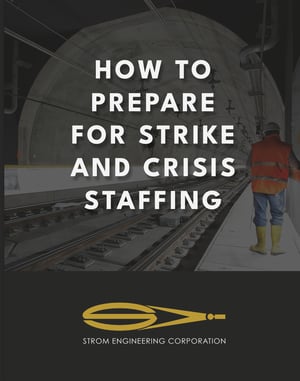

If you’re in the midst of collective bargaining or a labor dispute, it’s essential to know how business leaders can bargain in good faith to reach a resolution. As the nation’s leading strike staffing agency, Strom Engineering has years of experience working with business leaders and their companies to provide temporary solutions that lead to long-term results.
Good-faith negotiation requires mutual honesty from both parties. Even if you feel the other party is not negotiating in good faith, doing so yourself demonstrates to union leaders and employees alike that you hear and understand their wants and needs, and are looking to work together to find an equitable solution.
When negotiating in good faith, it’s imperative to consider the needs of both your business and your unionized workforce. Below are some ways to align and agree on solutions quickly.
When a labor dispute begins, stress and emotions can run high. . However, it’s important to remain focused and objective until a resolution is reached. All parties desire an agreement that is both equitable and sustainable, but emotions often obscure that goal.
Be prepared with facts and data when approaching the bargaining table, and remain calm and neutral without bias or hostility. While it may seem overwhelming at times, successful negotiations will lead to long-term partnership and trust between the union and the company.
Seeing a strike from your union’s perspective gives you a better understanding of the situation so you can form a viable solution and negotiate in good faith. Try to put yourself in your union’s shoes, and figure out the root of the issues. Listen, and ask yourself these questions:
A key component of negotiating in good faith is understanding “the other side” and not dismissing their wants. In some cases, employees just need to be heard and know that they’re being heard.
Related Content: Why Business Leaders Should Work Collaboratively with Union Leaders
If you know what your employees want beforehand, you’re already one step closer to finding a solution that suits both sides. First, have HR professionals document the company’s and union’s needs and wants. Next, consider all relevant factors and constraints facing the business, including market conditions, industry practices, and possible financial implications of various agreements. Finally, determine a strategy for addressing necessary points, structured around each party’s goals.
To reach a fair resolution, both parties might have to compromise on their wants and needs, but an equitable agreement will result in a balance of sustainable profitability and a proud, motivated workforce with a sense of value. Overall, negotiating in good faith will benefit everyone in the long term.
One of the best ways to avoid contention at the bargaining table is taking a proactive approach. Ongoing good faith communication between employees, union leaders and business leaders is essential. Listening to employee feedback and implementing solutions that address daily needs goes a long way toward building trust and respect.
For more ideas on how to create a culture of ongoing communication, read our blog: Why Business Leaders Should Work Collaboratively with Unions
While collaborating with the union may build trust and reduce friction, it’s important to have a plan in place ahead of contract negotiations. Our free guide for business leaders can help you ensure you have a roadmap to follow in the event of potential disruption.
 How to Create a Crisis Plan: Free Guide
How to Create a Crisis Plan: Free GuideStrikes and crises can happen, and when they do, preparations and planning are critical. Labor disputes can have a significant impact on operations, production, and overall business revenue, so it’s important to understand what to do and when to do it.
Strom Engineering is a complete solution provider and partner for businesses seeking to address the unfortunate possibility of a labor disruption.
Strom suggests a five-phase approach for mitigating the repercussions of a labor disruption.
Download our free ebook to learn more! This guide includes:
Strom Engineering is a national staffing and recruitment agency, with a particular focus on manufacturing, engineering, assembly, and other trade positions. We match skilled candidates to temporary or project staffing positions. Learn more about how it works and check out our case studies for more information.